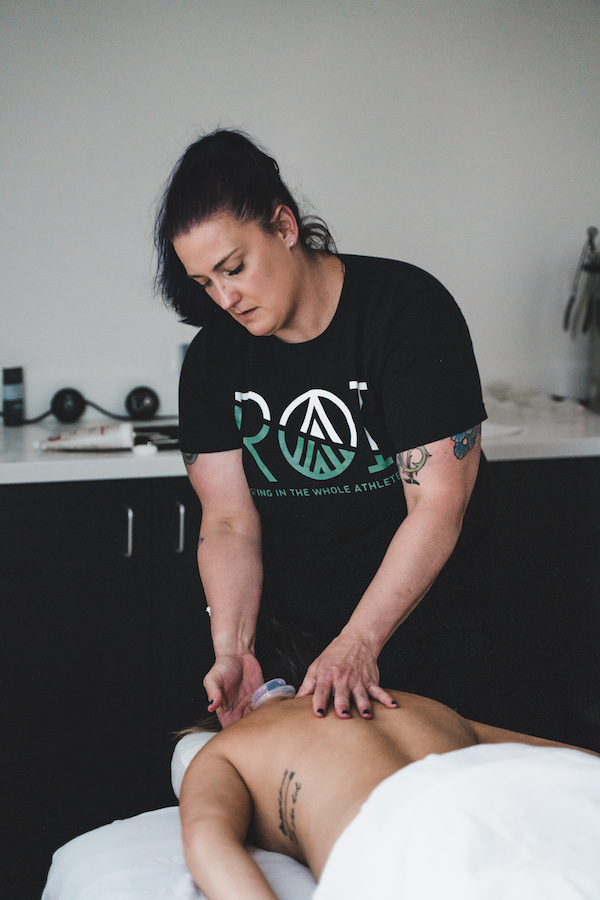Austin’s Cupping Therapy Specialists
Cupping is a therapy that utilizes the methodic placement of cups with a specialized suction technique to improve return to function for athletes via muscle stimulation. It’s particularly helpful in the treatment of aches and pains and in the treatment of soft-tissue injury. Cupping has been used in various cultures for thousands of years, and has evolved into its modern application in sports medicine today. However, if this is a new term for you, you may be wondering, “Exactly what is cupping?”
Cupping is said to promote quality of life through holistic healing by targeting underlying mechanisms of painful symptoms. It targets neural, hematological, and immunological systems in the body. Cupping is used in tandem with Team ROI’s integrated approach to physical therapy, providing elite athletes with specialized recovery plans that balance nutrition, massage, and alternative therapies with performance training and tracking.
What to Expect During Your Cupping Session
Each cupping session takes about 20 minutes and can be conducted in five steps. The first step includes primary suction. In this phase, the therapist locates specific points or areas for cupping and disinfects the areas. A cup is placed on the selected site, and the therapist sucks the air inside the cup manually. The cup is left on the skin for several minutes to stimulate blood circulation before the cups are removed.
How Cupping Therapy Promotes Recovery
Several theories explain the effectiveness of cupping as part of recovery treatment. Cupping is thought to be both a preventative therapy and a recovery therapy in sports medicine. It is thought to work by stimulating the neural, hematological, and immunological systems.
- Neural Recovery: Cupping influences chronic pain by altering the signal processing at the level of the nociceptors (nerve cell endings that initiate the sensation of pain), both of the spinal cord and brain. When the cupping stimulus is applied to the skin, anti-nociceptive effects alleviate pain and counter irritation. More specifically, the mechanical stimulation provides pain relief to nerve fibers linked to the Diffuse Noxious Inhibitory Controls (DNIC) system by creating a pain modulation pathway which has been described as the “pain inhibits pain” phenomenon. In other words, cupping allows for one pain to be masked by another, less intrusive pain. Ultimately, this leads to an increase in the frequency of impulses, leading to closure of the pain gates and more significant pain relief.
- Hematological: Skin receptors are activated when cups are applied to the skin, transmitting signals from the autonomic sensory nerves to the skin, causing it to swell and become tender. The entire process results in more blood circulation and blood supply to the skin and nearby internal organs, instigating new cell growth. Cupping may also be an effective method of reducing low density lipoprotein (LDL), and consequently may have a preventive effect against cardiovascular diseases (CVDs). It may also improve the immune function of blood cells by upregulating oxyhemoglobin and deoxyhemoglobin. As the carrier of hemoglobin, the red blood cell is an important defensive system. In a hematological sense, cupping is both a preventative and recovery therapy that fits well into an integrated practice that focuses on the treatment of the whole athlete.
- Immunological: There are several ways in which cupping stimulates the immune system. First, it irritates the immune system by making an artificial local inflammation, thus causing the body to respond. Second, cupping activates the complement system, which clears damaged cells and microbes from the body. Third, it increases the level of immune products in the body. The effects of cupping can also stimulate the thymus, increasing the flow of lymph fluid in the lymphatic system. In addition, it can trigger the body to produce histamine-like substances, and consequently strengthen the activity of tissues and organs, as well as the immunity.
More generally, cupping therapy tends to drain excess fluids and toxins, loosens adhesions, revitalizes connective tissue, increases blood flow to skin and muscles, stimulates the peripheral nervous system, reduces pain, controls high blood pressure, and modulates the immune system. However, like most therapies, there is the potential for side effects, side effects, which may include:
- Mild discomfort
- Burns
- Bruises
These side effects are temporary and fade over time, while the body continues to benefit from the therapy.
Expert Care
Our residency-trained specialists use a hands-on, science-based approach for cupping. Treatments start at $55 per session and should be integrated with complementary services, all designed to help each individual return to peak athleticism. Our customized plans are tailored to each athlete’s individual needs for optimal recovery outcomes. Progress is tracked by a doctor of physical therapy using hard data and recorded observations to ensure athletes are recovering safely without risk of re-injury.
Contact us by phone at 512.962.9141 or send a message to find out more about how to make cupping therapy a recovery aid on your journey towards fitness and wellness.

